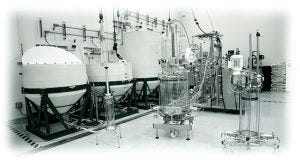- Business
- Sponsored Content
Ask the Expert: CHT Column Packing Is Easier Than You ThinkAsk the Expert: CHT Column Packing Is Easier Than You Think
Sponsored Content
On 6 September 2017, Mark Snyder (manager of the process chromatography R&D  applications group at Bio-Rad Laboratories) gave an “Ask the Expert” presentation on process-scale column packing with CHT ceramic hydroxyapatite media.
applications group at Bio-Rad Laboratories) gave an “Ask the Expert” presentation on process-scale column packing with CHT ceramic hydroxyapatite media.
Snyder’s Presentation
CHT is an incompressible mixed-mode chromatography medium using cation exchange and calcium-affinity interactions, and it is available in 40-μm and 80-μm particle sizes. This medium can be used to purify monoclonal, polyclonal, and bispecific antibodies; antibody fragments; other recombinant proteins and isozymes; viruses, viral particles, and vaccines; and supercoiled, single-stranded, or double-stranded DNA. It is particularly good at viral clearance and separating nucleic acids.
The nominal packing density of CHT media is about 0.63 g/mL of packed bed. This value is determined by placing a known mass of the powdered medium into a graduated cylinder, tapping the cylinder several hundred times, and then measuring the volume.
For real-world packing, however, 0.60 g/mL is a more appropriate value. Because CHT media are incompressible, a column is packed once all particles have settled. Users can apply either flow or axial packing for bed consolidation, packing 40-μm media at 150 cm/hr and 80-μm particles at 300 cm/hr.
Packing CHT media is a four-step process: making a slurry, transferring it into a column, packing, and then qualifying. After calculating the amount of dry powder needed, users add it to a buffer. The medium will absorb about 90% of its own volume in buffer during initial hydration. The slurry concentration should be <50%, and mixing can be either manual with a plastic paddle (using a J stroke) or motorized with a low-shear impeller. A diaphragm pump or column operating in syringe mode can be used to transfer the slurry to a level column with a ≤10-μm frit for 40-μm media.
For bed consolidation, users can apply flow or piston movement (or both) until all particles are at the bottom. This noncompressible medium bed will not rebound, so packing is now complete. A user then lowers the column’s head plate, leaving a gap of 1–5 mm, without pressing it into the bed (which would crush the particles).
Columns then are qualified by both asymmetry and height-equivalent to the theoretical plate (HETP) testing using conductivity or another method (e.g., UV). Test solutions should have the same phosphate concentration as the running buffer. A small second peak usually will follow the main peak when NaCl is used as a tracer.
Optimization studies showed acceptable test results even when users merely poured slurry into a column and left it to settle by itself overnight. Less optimum results came only when a 20-mm or greater headspace was left.
Questions and Answers
Is the tap-settled density calculated as an average, or does it vary per lot? It can vary slightly per lot. People who use 0.60 g/mL seem to get about the exact bed volume they want.
What is the largest diameter column that has been successfully packed with
this medium? All diameter columns have been successfully packed. I assisted with packing a stainless steel 1.8-m column.
What is the recommended slurry concentration? I like to use 40%. That seems to be a nice trade-off between not having too dense a slurry and not needing too large a tank. In some situations, you might want a thinner slurry. Anywhere between 30% and 40% is good. You will need a column tube that is at least twice the working volume of your final bed. So, if you are going to pack a 20-cm tall column, you need a working bed volume of at least 50 cm.
Is repacking possible? Repacking is possible. We have videos on our YouTube channel about how to do it, and I direct you there: bio-rad.com/chtpacking.
What is the best technique or measurement for leveling the column? The best technique is to use a construction level (a glass-bubble level). Make sure you have it on a part of the column that you know is flat to begin with, usually the top flange. Place the level on the top of the column in some orientation, then make sure you turn it 90° to check that the column is level on both the x and y axes.
How level does it have to be? If you leave a 5-mm gap, the column could be a little less level than if you leave a 1-mm gap. If the column is slightly unlevel, and you break one or two beads as a result, that is not a problem. The more beads you break, however, the bigger the problem is. So try to get the column as level as possible.
More Online
The full presentation of this webcast (with slides and audio) can be found with all of our other Ask the Expert webcasts in the Multimedia section of the BioProcess International website.
You May Also Like






